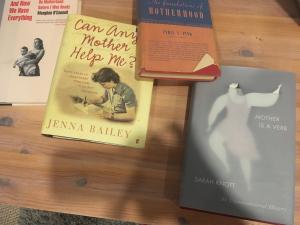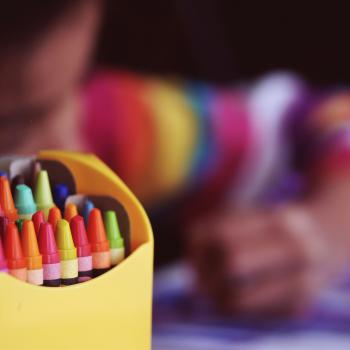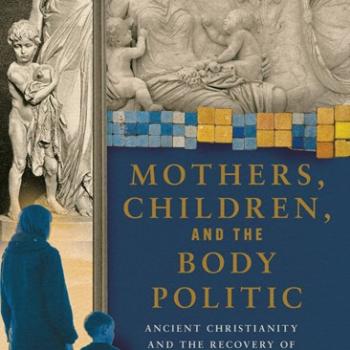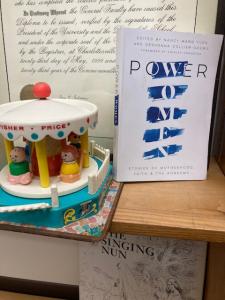Present day visions of motherhood may feel so askew that we might look in many directions–religion? the past? other places?–for correction.
The current issue of the journal Image carries an arresting art piece, “Motherhood: A Visual Contract,” aiming to find some use in religious imagery of motherhood from the past. The art and text from Israeli-born London artist Leni Dothan engage contemporary perplexities in ways that echo a noteworthy book from earlier this year, Sarah Knott’s Mother is a Verb. Both have historical approaches. The uses they hope to derive from history merit some joint reflection.
Knott strives, with the elusive documentary evidence of women in the past, to frame current experience in light of the way it used to be for those with child. The book impresses on a number of levels, blending the historical and personal. The British Knott, associate professor of history and gender studies at Indiana University, has sharp eyes and apt words for the striking and strange in motherhood past and present. The book weaves tidings of her pregnancy and early motherhood around those of her sources. But its success at doing so invites questions about why history is the right tool to do what she aims. Does reckoning female involvement with children as active, rather than passive or invisible, help retrieve women from obscurity and the presumption of having accomplished little? Does seeing mothers’ struggles in the past help us see them more clearly in our own time? Does finding precedent for behaviors now deemed obvious help excavate them from the taken-for-granted and explain why we do should retain them—or should not?
A case could be made for affirmative answers to all of the above. But we might not rush to those answers too quickly.
Reading Knott’s book, I kept recalling a feeling common to my own days with young children, a kind of startlement that this was how it was and that people had allowed things to get this way. Those first few nights with a newborn in the house when the baby wakes up—scared? cold? hungry? Maybe some or none or all of those things, but crying urgently and in need of someone, mother, to go, soothe, and feed. Really? Is this supposed to be how it is? When does sleep come? It’s an insistent anxiety insinuating itself when one is alone awake in a dark house, one’s own body all that holds back a newborn’s desolation. Those days feeding a baby out of one’s body and getting that hard-labored milk vomited all down the back moments later. Really? This is normal? Those dire diaper-changes, stripping soaked clothes off an infant whose limbs balk at bending through sleeves, because he has leaked all out, again, really?
And those are the startlements that come with happy outcomes of healthy babies. Knott recognizes, as a New York Times photo essay recognizes, that maternity often can be more about miscarriage and loss. As Knott narrates her motherhood and the experience of other mothers, she seems sometimes stunned that she should find herself in such situations. Not, how did she become a mother, but how did motherhood become like this? Given the way we in the United States handle birth and work and family, she and we, upon having children, might find ourselves without a thick network of other mothers to assure her that, yes, this is how it is.
For that reason, finding corroboration in the past could be useful. See, mothers from many years ago attest, we could have told you how it is. Because the historian has given us voice we are telling you, this is how it is. One reason to look to the past is to find support in this common work from women in the past who did it, often under hardship more acute than ours. “What are the many different pasts of becoming a mother?” Knott asks. These pasts need to be told differently than histories of other things: “When not on maternity leave, I tell my students grand narratives about the late-eighteenth-century transition from kingdoms to republics….About mothering an infant, I am on smaller, grittier ground. The drama is piecemeal and the record is fragmentary.” She turns this piecemeal character into a virtue:
Perhaps the best way to explore the pasts of having a baby is to put grand narratives aside, and pay attention to the fragments and anecdotes. Perhaps the best way to explore mothering’s many pasts is to build a trellis of tiny scenes, pursuing the many different actions involved. Conceiving, miscarrying, quickening, carrying, birthing, And then, cleaning, feeding, sleeping, not sleeping, providing, being interrupted, passing back and forth. These make up the visceral ongoingness, the blood and guts of being ‘with child.’ The verbs.
For Dothan, what the past gives women is not fellowship in common experience but constraint. What we learn of mothers in the past, she avers, is usually of a few unattainable models—mostly the Virgin Mary—and that composes a past that fails to support and instruct. By valorizing extraordinary women, the outliers and saints, the past hands down to women a model that binds, that makes “ideological prisons.” Her art, reinterpreting conventional maternal poses to show women’s complexity, suggests that a liberated present might enable a revision of the past. Women can free themselves from the straitjacket of “obedient mothers” by seeing them differently and by refashioning themselves. By this “Visual Contract,” the artist revises motherhood and invites viewers to follow.
Dothan’s work calls for sustained looking. She gives us a not-quite-Madonna, clothed in red with an exposed breast, who sleeps as wearily as the child in her arms. Dothan shows women giving and taking grief and comfort. In one piece, the bodies of a mother and young son are composed in a shape like a cross that turns, imagining Mary and Jesus both in the tomb. Most moving for me was Double (2015, Wooden structure, concrete wall), a photo of a double coffin, one side adult-sized and the other side proportioned for a child, but with no partition or lid. The text says of the image:
For hundreds of years, the mother has been presented as a predetermined, professional mourner. This work proposes an alternative iconography. Forged as an asymmetrical heart, the double coffin imagines a mother who chooses to die with her child, refusing to accept either his destiny or her own. The coffin appears custom made to fit a particular parent and child, and thus the structure itself becomes a replacement for the usual notation of death: dd/mm/yyyy. It stands quiet and foreboding before parents, who cannot bear the thought of sacrificing their children. Not for God, not for the state, not for anyone.
That is not what I see in this image. Double looks like a piercing statement of what is, what, to some degree, Knott describes in her book. Mother and child are joined in present and future. Boundaries, privacy, distinctions, growing apart, all those may happen, but their eventuality imposes a division on what remains, for the mother, an open fact. There is no way to set the child into pain, suffering, or death that does not belong to her too.
Dothan’s art and Knott’s writing both ask a lot of history on behalf of present motherhood. What should history offer women who, bearing children, find current mothering ways out of kilter? Can it help, by showing something different, even by showing something worse but in a different way? Can compassion for the ways mothers have labored and suffered nourish empathy for other mothers around us now?














